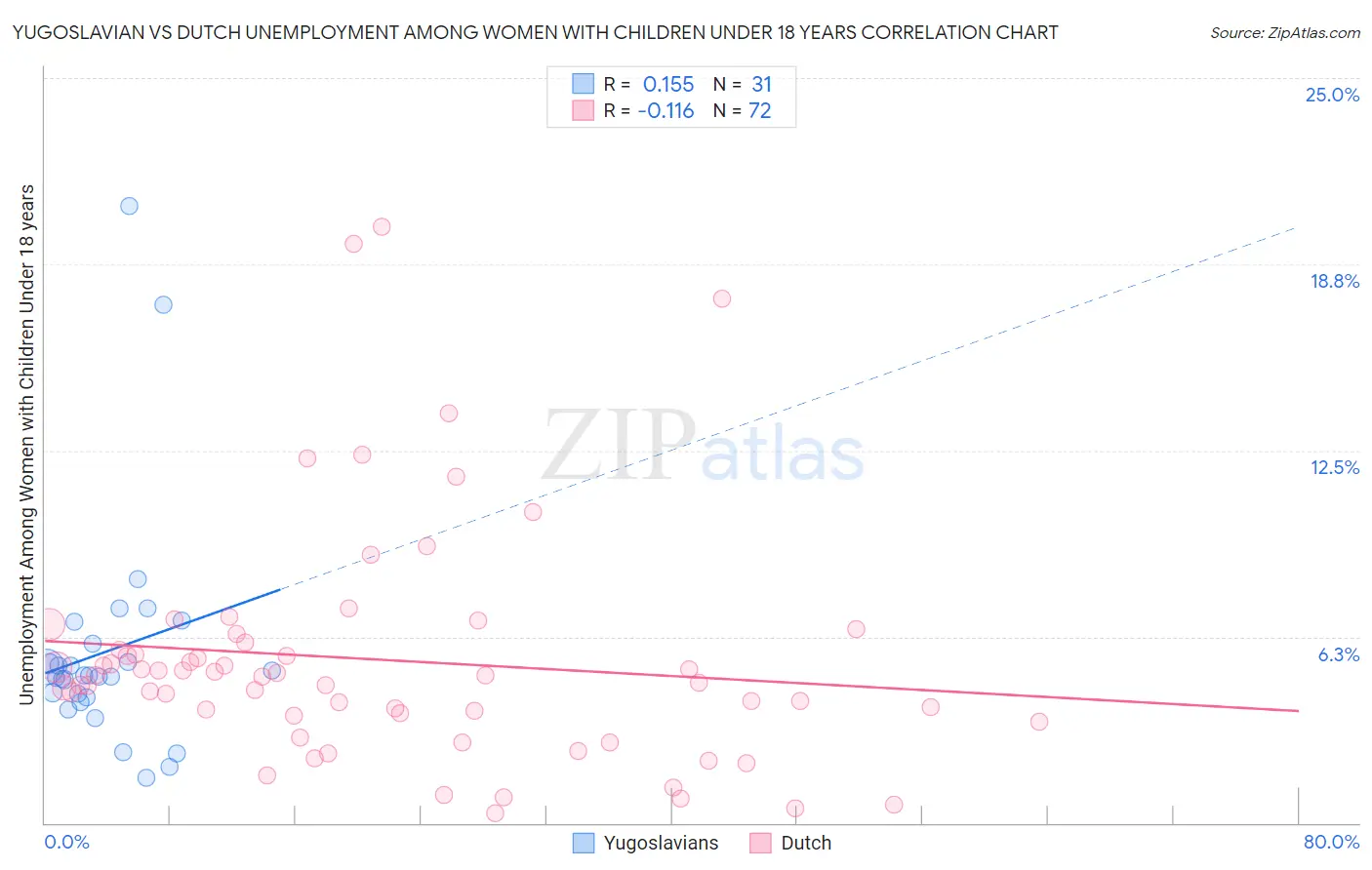Yugoslavian vs Dutch Unemployment Among Women with Children Under 18 years
COMPARE
Yugoslavian
Dutch
Unemployment Among Women with Children Under 18 years
Unemployment Among Women with Children Under 18 years Comparison
Yugoslavians
Dutch
5.1%
UNEMPLOYMENT AMONG WOMEN WITH CHILDREN UNDER 18 YEARS
98.3/ 100
METRIC RATING
51st/ 347
METRIC RANK
5.0%
UNEMPLOYMENT AMONG WOMEN WITH CHILDREN UNDER 18 YEARS
99.3/ 100
METRIC RATING
32nd/ 347
METRIC RANK
Yugoslavian vs Dutch Unemployment Among Women with Children Under 18 years Correlation Chart
The statistical analysis conducted on geographies consisting of 276,335,631 people shows a poor positive correlation between the proportion of Yugoslavians and unemployment rate among women with children under the age of 18 in the United States with a correlation coefficient (R) of 0.155 and weighted average of 5.1%. Similarly, the statistical analysis conducted on geographies consisting of 503,486,038 people shows a poor negative correlation between the proportion of Dutch and unemployment rate among women with children under the age of 18 in the United States with a correlation coefficient (R) of -0.116 and weighted average of 5.0%, a difference of 1.8%.

Unemployment Among Women with Children Under 18 years Correlation Summary
| Measurement | Yugoslavian | Dutch |
| Minimum | 1.5% | 0.34% |
| Maximum | 20.7% | 20.0% |
| Range | 19.2% | 19.7% |
| Mean | 5.8% | 5.5% |
| Median | 4.9% | 4.9% |
| Interquartile 25% (IQ1) | 4.2% | 3.6% |
| Interquartile 75% (IQ3) | 6.0% | 5.9% |
| Interquartile Range (IQR) | 1.8% | 2.3% |
| Standard Deviation (Sample) | 3.9% | 3.9% |
| Standard Deviation (Population) | 3.8% | 3.9% |
Demographics Similar to Yugoslavians and Dutch by Unemployment Among Women with Children Under 18 years
In terms of unemployment among women with children under 18 years, the demographic groups most similar to Yugoslavians are Immigrants from Japan (5.0%, a difference of 0.080%), Lithuanian (5.0%, a difference of 0.11%), Northern European (5.0%, a difference of 0.33%), British (5.0%, a difference of 0.46%), and Immigrants from Korea (5.0%, a difference of 0.58%). Similarly, the demographic groups most similar to Dutch are Croatian (5.0%, a difference of 0.020%), Cypriot (5.0%, a difference of 0.11%), Immigrants from South Central Asia (5.0%, a difference of 0.22%), Luxembourger (5.0%, a difference of 0.27%), and Mongolian (5.0%, a difference of 0.33%).
| Demographics | Rating | Rank | Unemployment Among Women with Children Under 18 years |
| Cypriots | 99.3 /100 | #31 | Exceptional 5.0% |
| Dutch | 99.3 /100 | #32 | Exceptional 5.0% |
| Croatians | 99.3 /100 | #33 | Exceptional 5.0% |
| Immigrants | South Central Asia | 99.2 /100 | #34 | Exceptional 5.0% |
| Luxembourgers | 99.2 /100 | #35 | Exceptional 5.0% |
| Mongolians | 99.2 /100 | #36 | Exceptional 5.0% |
| Poles | 99.2 /100 | #37 | Exceptional 5.0% |
| Bhutanese | 99.2 /100 | #38 | Exceptional 5.0% |
| English | 99.1 /100 | #39 | Exceptional 5.0% |
| Greeks | 99.0 /100 | #40 | Exceptional 5.0% |
| Immigrants | Bosnia and Herzegovina | 99.0 /100 | #41 | Exceptional 5.0% |
| Eastern Europeans | 98.9 /100 | #42 | Exceptional 5.0% |
| Turks | 98.9 /100 | #43 | Exceptional 5.0% |
| Immigrants | Moldova | 98.9 /100 | #44 | Exceptional 5.0% |
| Immigrants | Malaysia | 98.8 /100 | #45 | Exceptional 5.0% |
| Immigrants | Korea | 98.7 /100 | #46 | Exceptional 5.0% |
| British | 98.7 /100 | #47 | Exceptional 5.0% |
| Northern Europeans | 98.6 /100 | #48 | Exceptional 5.0% |
| Lithuanians | 98.4 /100 | #49 | Exceptional 5.0% |
| Immigrants | Japan | 98.4 /100 | #50 | Exceptional 5.0% |
| Yugoslavians | 98.3 /100 | #51 | Exceptional 5.1% |